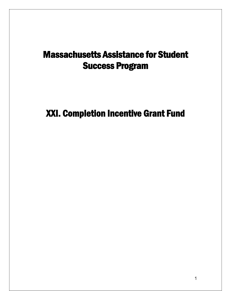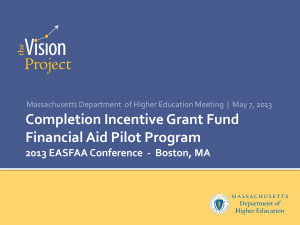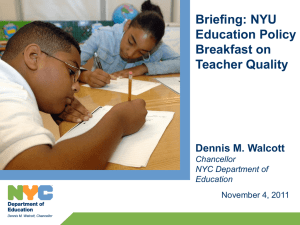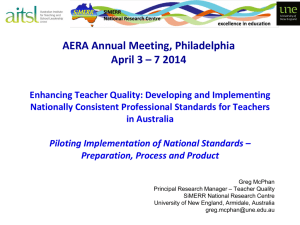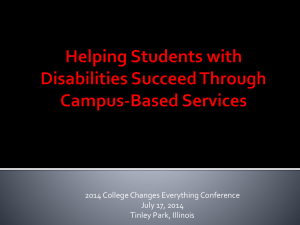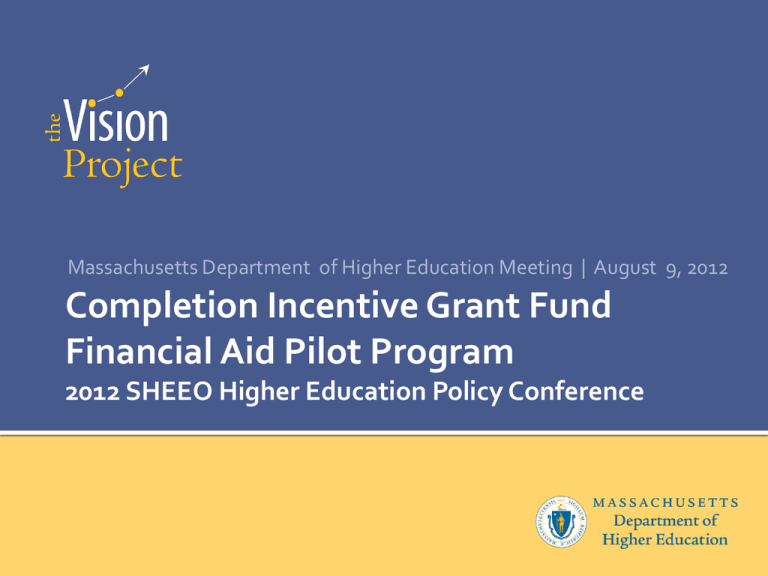
Massachusetts Department of Higher Education Meeting | August 9, 2012
Completion Incentive Grant Fund
Financial Aid Pilot Program
2012 SHEEO Higher Education Policy Conference
A Public Agenda for Higher Education in Massachusetts
The Vision Project: The Vision
*****
We will produce the best-educated
citizenry and workforce in the nation.
We will be a national leader in research
that drives economic development.
*****
The Vision Project
Outcomes
College-going rates of high school graduates
Graduate and student success rates
Alignment of degree production with key areas of
workforce need
Academic achievements on campus-level and national
assessments of learning
Comparable learning outcomes among different student
population groups
Financial Aid Pilot Program
The Problem
When students drop out of college,
Massachusetts does not get a full return
on its investment, and students are
left in debt without a credential.
The Question
Can financial aid resources be used in
innovative ways to increase student
certificate and degree completion rates?
Financial Aid Pilot Program
The Process
Working Group on Graduation
and Student Success Rates
Commissioned background
paper on financial aid
incentive policies
Recommended that
Massachusetts leverage
financial aid resources to
increase student success
Recommended specialized
working group—
Financial Aid Policy Advisory
Group
Financial Aid Pilot Program
The Process
Financial Aid Policy Advisory Group
Charged to design the framework and guidelines for
financial aid pilot program that:
▪
▪
▪
▪
Will increase completion rates for degrees and certificates
Will target low-income students at our public institutions
Is based on evidence-based research
Is scalable
Financial Aid Pilot Program
Policy Advisory Group
Membership was representative of public college campuses
and external stakeholders
Work of the Policy Group was guided by national experts
David Longanecker, President
Western Interstate Commission for Higher Education (WICHE)
Brian Prescott , Director of Policy Analysis and Research
Western Interstate Commission for Higher Education
Financial Aid Pilot Program
The Research
Financial Aid Pilot Program
The Outcome
Completion Incentive Grant Fund
Will run from Fall 2012 to Spring 2016
Targets low-income, first-time students
▪ One cohort - comprised of students from 11 colleges
and universities representing all segments of public
higher education
▪ 3,500 students randomly divided into two groups,
Control and Treatment
Completion Incentive Grant Fund
How Will It Work
$3 million dollar annual projected
expenditure
2,000 maximum grant per year
$8,000 over four-year period
Students may earn incentive during summer
if annual maximum award was not received
during traditional fall & spring semesters
Completion Incentive Grant Fund
How Will It Work?
Students must:
Earn 9–15 credits
per semester with
minimum GPA of 2.0
Maintain continuous
enrollment up to four years
Sign annual contract
of understanding
Utilize campus
support services
Completion Incentive Grant Fund
How Will It Work?
Students will receive incentive grants in
increments of $100 per credit each
semester as follows:
$1000
12 credits in a semester = $700
15 credits in a semester =
▪ 4-year students must complete a minimum of
12 credits to receive the incentive
9 credits in a semester =
$400
Completion Incentive Grant Fund
How Will It Work?
Institutions must:
Agree to program guidelines
Provide students with array of
academic support services
Report institutional data
as required
Program will be evaluated:
Quantitative and Qualitative
Completion Incentive Grant Fund
Program Evaluation
Evaluation will begin with the initial year of the pilot:
Quantitative Evaluation
Internal
External Evaluator
Qualitative Analysis
External Evaluator
Completion Incentive Grant Fund
Evaluation
The analysis/evaluation of the pilot will focus on the following
questions:
What effect does the CIGF pilot have on the rates at which
students accumulate college level credit, the rate at which they
persist, transfer, and complete degrees and certificates?
How do these rates differ for students by race/ethnicity, sex,
age, first generation status, income , level of academic
preparation, among other characteristics?
To what extent does participating in the pilot affect student
financial aid packages and their choices about how to finance
their education (especially the balance between grants, work
and loans)?
Questions


